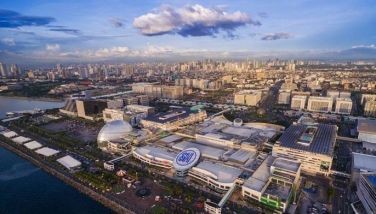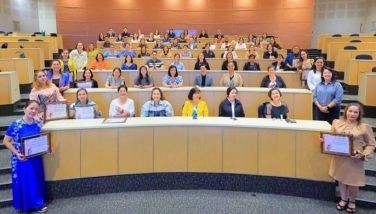NIA seeks return of irrigation fees
July 29, 2001 | 12:00am
Citing huge losses of about P300 million a year from operations, the National Irrigation Administration said it would ask President Arroyo to allow the agency to charge the old irrigation service fees (ISFs) of two cavans per hectare during the wet season crop and three cavans per hectare for the dry season crop.
In a press conference, NIA Deputy Administrator Orlando Hondrade said the NIA board, chaired by Agriculture Secretary Leonardo Q. Montemayor, agreed to endorse to the President the old IFS rates so that it will be in a position to pay back wages and GSIS remittances of field personnel as well as operation and maintenance costs for its national and communal irrigation systems.
The board is meeting again early August to draft the endorsement to President Arroyo, which Hondrade said is not being opposed by irrigators associations and beneficiaries of the NIA systems.
The ISFs were abolished by deposed President Joseph Estrada when he delivered his first State of the Nation Address in 1998 but was later revised when NIA asked the adoption of a socialized irrigation fee system, mandated by Administrative Order No. 17 of August 1998.
Since then the NIA has been using the socialized ISF, which, however, is not enough to cover for the cost of operation and maintenance of existing systems and personnel salaries and allowances. Because of the heavy losses, NIA was also unable to finance its rehabilitation of existing systems, Hondrade said.
Dialogues conducted by NIA with beneficiaries, irrigators associations and even the most radical farm groups have so far elicited positive response from the peasants to the return to old ISF rates "provided NIA would give a better service to the farmers in terms of extension services and the provision of seeds and farm inputs," Hondrade said.
For this purpose, Montemayor, at the recent board meeting of NIA, asked the National Agriculture and Fishery Council (NAFC) and the Fertilizer and Pesticides Authority to take a more aggressive position in delivering the farm services being required by the NIA beneficiaries, who will be paying higher ISF rates.
Hondrade said that once approved by the President, the return to old ISF rates will become effective at the dry season crop of 2002.
NIA, being a government owned or controlled corporation, depends largely on its income from collection of ISFs for its O&M requirements.
The ISF is charged to the farmers in the form of improved services in the operation and maintenance of national irrigation systems.
The ISF helps maintain the operation and maintenance and rehabilitation of existing irrigation structures, which have substantially deteriorated and outlived their lifetimes, the NIA said.
The NIA cannot also rely on subsidy released from the National Government because they usually take time, if such budget exists at all, thus the delivery of water for irrigation would be adversely hampered.
"Unlike roads, bridges and other public works facilities which are free for public use, irrigation serves only a limited sector, namely the farms," NIA said.
In 1991, the National Economic and Development Authority Infracom Technical Board even supported an increase in the ISF (which has been in effect since 1975) to sufficiently cover O&M costs.
In a press conference, NIA Deputy Administrator Orlando Hondrade said the NIA board, chaired by Agriculture Secretary Leonardo Q. Montemayor, agreed to endorse to the President the old IFS rates so that it will be in a position to pay back wages and GSIS remittances of field personnel as well as operation and maintenance costs for its national and communal irrigation systems.
The board is meeting again early August to draft the endorsement to President Arroyo, which Hondrade said is not being opposed by irrigators associations and beneficiaries of the NIA systems.
The ISFs were abolished by deposed President Joseph Estrada when he delivered his first State of the Nation Address in 1998 but was later revised when NIA asked the adoption of a socialized irrigation fee system, mandated by Administrative Order No. 17 of August 1998.
Since then the NIA has been using the socialized ISF, which, however, is not enough to cover for the cost of operation and maintenance of existing systems and personnel salaries and allowances. Because of the heavy losses, NIA was also unable to finance its rehabilitation of existing systems, Hondrade said.
Dialogues conducted by NIA with beneficiaries, irrigators associations and even the most radical farm groups have so far elicited positive response from the peasants to the return to old ISF rates "provided NIA would give a better service to the farmers in terms of extension services and the provision of seeds and farm inputs," Hondrade said.
For this purpose, Montemayor, at the recent board meeting of NIA, asked the National Agriculture and Fishery Council (NAFC) and the Fertilizer and Pesticides Authority to take a more aggressive position in delivering the farm services being required by the NIA beneficiaries, who will be paying higher ISF rates.
Hondrade said that once approved by the President, the return to old ISF rates will become effective at the dry season crop of 2002.
NIA, being a government owned or controlled corporation, depends largely on its income from collection of ISFs for its O&M requirements.
The ISF is charged to the farmers in the form of improved services in the operation and maintenance of national irrigation systems.
The ISF helps maintain the operation and maintenance and rehabilitation of existing irrigation structures, which have substantially deteriorated and outlived their lifetimes, the NIA said.
The NIA cannot also rely on subsidy released from the National Government because they usually take time, if such budget exists at all, thus the delivery of water for irrigation would be adversely hampered.
"Unlike roads, bridges and other public works facilities which are free for public use, irrigation serves only a limited sector, namely the farms," NIA said.
In 1991, the National Economic and Development Authority Infracom Technical Board even supported an increase in the ISF (which has been in effect since 1975) to sufficiently cover O&M costs.
BrandSpace Articles
<
>
- Latest
Latest
Latest
May 14, 2024 - 3:43pm
By Ian Laqui | May 14, 2024 - 3:43pm
April 10, 2024 - 5:12pm
By Ian Laqui | April 10, 2024 - 5:12pm
March 4, 2024 - 3:32pm
By Ian Laqui | March 4, 2024 - 3:32pm
March 4, 2024 - 2:12pm
By Kristine Daguno-Bersamina | March 4, 2024 - 2:12pm
February 17, 2024 - 2:31pm
February 17, 2024 - 2:31pm
Recommended




























